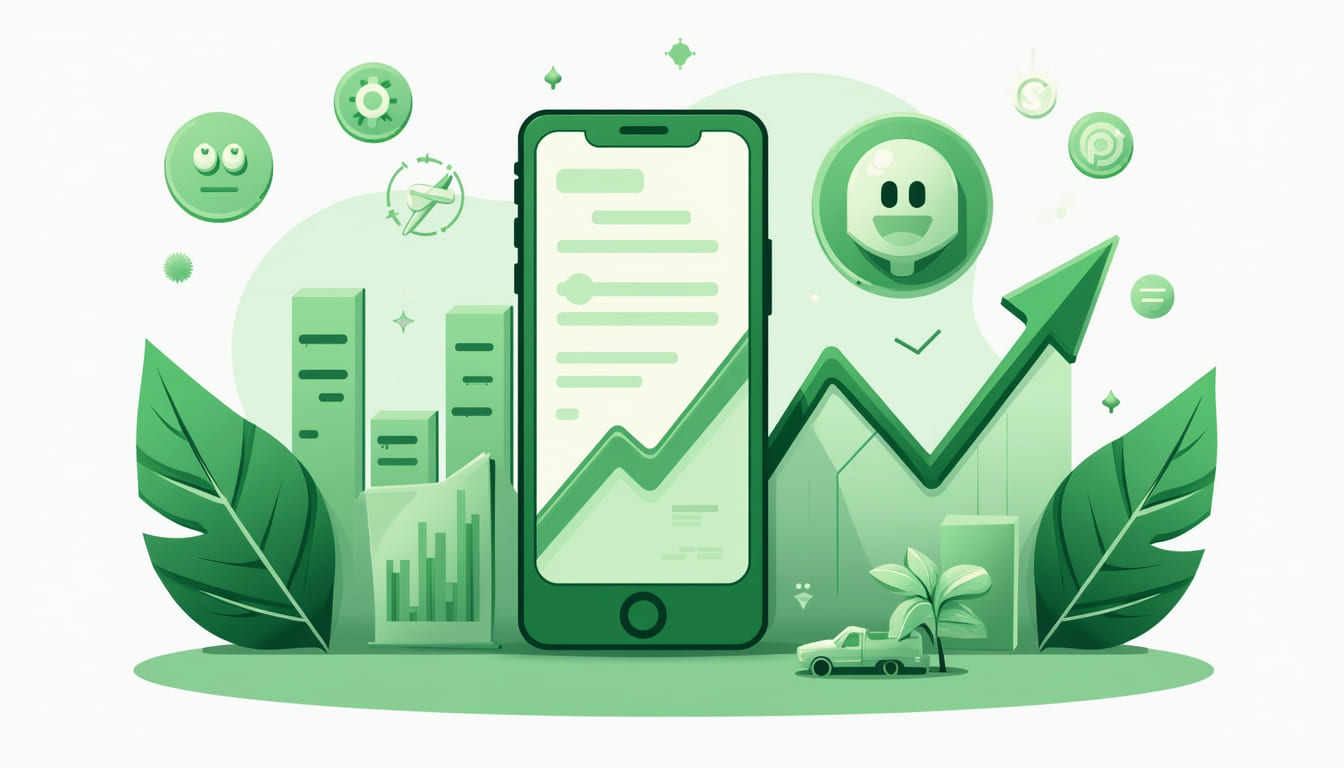.png)
Native App Development: Pros, Cons, and Use Cases
Native App Development in 2026: The Ultimate Guide for Startups and Businesses
Even in 2026, building a native app is still a preferred choice for startups and businesses willing to develop robust mobile apps. Native apps are developed with a specific platform in mind such as iOS or Android and can provide better performance, more integration with device capabilities, and higher quality user experiences than alternatives. While the battle of cross platform app development vs native rages on, Native wins out when you need good hardware level access to your apps, high security and responsiveness.

React native app development cost is a priority for most companies while planning their mobile strategy. React Native supports the creation of apps that run on both iOS and Android from just one codebase, which can be a cost-effective and faster way to go to market. Companies typically align with an offshore react native app development company or hire developers from a react native app development agency, in case they want to benefit from cost-effectiveness yet with the desired quality. Most startups look to employ the services of react native app developer with cross-platform know-how combined with expertise in native coding for both a balance.
For businesses that are specific to the Apple ecosystem For projects only related to the Apple system, you need an ios native app development company where you can get a tailored approach for iOS performance, security and user experience. At the same time, developments in cloud native app development services allow apps to "smarten up" using cloud infrastructure for improved scale out and maintenance, allowing businesses to transition to more modern architectures.
The Decision to go with Cross Platform Native App Development The decision between cross platform native app development vs pure native is essentially based upon the complexity of your project, performance you need and budget you have. Cross-platform tools such as Flutter and React Native make it easier to target broader audiences in a shorter period of time; however, there are still cases where native development shines for maximum performance or when leveraging advanced device capabilities.
1.Technology and Tools
Native app development is the creation of apps that are written and coded for a specific platform, such as iOS or Android using the companies’ preferred language (Objective-C/Swift OS X / Java). For iOS, Swift and Objective-C are the predominant languages that developers use, and Kotlin and Java dominate for Android apps. These are languages that enable the app to take advantage of the device’s hardware and deliver an appealing user experience. Xcode for iOS and Android Studio for Android are the primary development environments. Xcode provides you with everything you need to create great apps, including a code editor, debugging tools, and the iOS Simulator to test your app; Android Studio includes all the tools needed for building any type of Android app. And popular SDK’s such as ARKit(iOS) and Firebase (Android) make it relatively easy for developers to integrate with advanced features.
Programming Languages Used (Swift, Objective-C for iOS; Kotlin, Java for Android)
The main languages for native iOS app development are Swift and Objective-C. Swift is a powerful, yet fast, easy-to-understand language that's the perfect for newcomers to explore their full range of skills thanks to safer code and improved performance as well as even more at-a-glance know-how with concise syntax! Objective-C is an older language with more idiosyncratic syntax, but good legacy code interop and powerful dynamism. Android has also switched to Kotlin as main encouraging language by Google (which is modern with null safety and syntaxes are easier to understand). Old-but-good Java is the classic for Android development – it’s in use by most developers and backed up by the greatest number of tools, however its syntax is more verbose and its design older.
Development Environments (Xcode, Android Studio):
Apple’s iOS has its very own IDE and that is Xcode. It has facilities for coding, interface design, testing debugging and deploying apps. This tool provides simulators for iOS versions and device types. Android Studio is the official IDE for Android, but it also has a powerful code editor, emulator, debugger and other vital tools to help you build your app. And both are holistic tools offering a range of features and optimization aids that come together to smooth development and the quality of your app across baseline devices.
Popular SDKs, APIs, and Tools:
iOS apps regularly use SDKs such as ARKit (Augmented Reality), HealthKit (Health Data) and CoreML (Machine Learning) in order to provide the advanced and innovative functionalities. Android developers leverage Google Play Services for location, Firebase for backend services and CameraX to control camera operations at closer levels. Think CocoaPods that iOS developers use to manage third party libraries - there is the equivalent of Android Jetpack, a collection of components and tools for building GUI, implementing architecture components and managing lifecycle. These tools assist developers in accelerating applications with platform-specific optimizations.
Looking towards the future — 2025-2026: As native app development continues to develop, emerging trends are helping to forge its future. The rollout of 5G networks makes possible faster data speeds and lower latency, which will allow apps to offer richer, all-the-time experiences. Advances in AI and ML drive smarter apps tailored to user engagement and content dynamically. AR is revolutionizing sectors through providing an immersive, interactive experience. At the same time, new UI/UX trends concentrate on enabling intuitive and minimalistic designs that work seamlessly across various screen sizes including foldable devices. Native apps can also rely on more advanced hardware features, such as better camera sensors or biometric security, and multi-core processors that offer greater speed.
2. Trends and Innovations
Response to the Rise of New Technologies (5G, AI, AR, ML)
The rise of 5G connectivity considerably enhances the speed of mobile apps by decreasing the latency period, which in turn makes real-time functionalities such as live video streaming and online gaming a possibility. AI and ML inbuilt in native apps enable automating tasks, predicting user behavior, and delivering experiences personalized in real-time. For instance, AI enabled chatbots, recommendation engines and voice assistants bring better usability. Augmented Reality (AR) apps, built on top of frameworks such as ARKit, offer immersive experiences for gamers, shoppers, and learners. This is the tech that powers smart, fast and context-aware native apps - it changes how users use mobile.

Latest Trends in User Interface/User Experience Designs for Native Apps
Large UI/UX design for native apps is all about minimal simplicity, fluid animations and accessibility. Clean designs strip away anything that is not absolutely necessary and concentrate on the essentials. Responsive layouts adapt perfectly to any screen size, from phones to tablets and even Posters. Intuitive gesture operation instead of button controlling and complicated settings. Dark theme and user-friendly themes make your work more comfortable. Today, developers focus on the design that is user-centric that enables personalization and adaptive interfaces fuelled by AI. The use of voice-activated controls and haptic feedback helps to enhance the experience. These are the trends that keep “native apps” both user-friendly, engaging, and attractive to a wide variety of users in different types of devices.
Advances in device hardware exploited by native apps
Native apps make the most of the device’s features and capabilities. A sophisticated camera system facilitates real-time image processing, facial recognition and AR experiences. Multi-core processors and dedicated AI chips expedite complex calculations, enhancing app performance and responsiveness. Biometric sensors such as fingerprint and face ID, increase security level of the phone but also makes life more convenient. Gyros, accelerometers and GPS provide accurate motion sensing and location services. The app runs longer thanks to battery performance enhancements. Native features Apps for iOS, Android, and Windows More adapted to hardware By allowing native development app is more optimized in using hw capabilities End- user experience.
3. Use Cases and Industry Applications
Native apps are used for a variety of industries, including social media, healthcare, banking/finance, entertainment and utilities. Native like Interaction & rich media is made accessible on platforms such as Instagram using native development. Healthcare apps such as mySur can connect to wearables which help in personal management. Finance apps such as those from NerdWallet provide secure tools for tracking spending and credit. Native APIs for premium-quality streaming and offline media playback on entertainment services such as Spotify. Native apps address business needs with higher performance, reliability and security, leading to greater user engagement and retention. They use device capabilities such as cameras, GPS or biometric sensors to provide personalized experiences that drive customer satisfaction and growth.

Apps Verb Type Built Natively
Our native app development works for different type of applications in all sectors. Social applications like Instagram and TikTok are designed to maximize fluid user interactions and multimedia handling. Healthcare applications monitor users’ health data and are synchronized with a wearable product in order to achieve customized care. Finance apps provide for secure transactions and data protection that are essential to banking and investing applications. Entertainment applications such as Spotify focus on seamless audio streaming and offline usage. When it comes to ride-hailing companies like Uber, so much hinges on real-time GPS tracking and quick data updates. These applications use platform-specific development to create highly responsive and reliable user experiences through interaction directly with device hardware And they offer the same harmonized user experience as C#/XAML apps on the device.
Case studies Examples of Native Apps that have Succeeded/outperformed
Top native apps These industries are showing us the absolute best in innovation through user experience. Instagram employs native development to power features such as Stories and Reels, thus achieving instant loading times and AI-algorithmic content suggestions. The native Spotify app also has offline download support and can be controlled from mobile devices themselves. Uber uses all of it’s own backend for real-time ride dispatching, GPS and credit card transactions. WhatsApp A trusted messaging service that takes almost no bandwidth and is end-to-end encrypted. Heavy video processing and real time updates charged by TikTok’s native app. In health care, mySugr applies native tech to communicate with wearables for critical health information. The following success stories show how native apps help grow your business and retain your customers.
What Problems Do Native Apps Solve And How They Drive Value To Business
Native apps help to solve individual business challenges as they provide faster, more reliable and secure features in comparison with web or hybrid applications. They provide writers with full access of what the device they run on are capable of, and can access next-gen capabilities (such as computer vision or location tracking) and connect to a hardware in any devices that support those integrations — camera, GPS, biometrics or sensor functionalities. Offline support in Native apps is also an impeccable feature, important for keeping users based on your application. A polished UI/UX means a better feel, which leads to less churn and increased session time. Push notifications make sure users are engaged and up to date. Native apps create secure, personalized experiences that businesses can rely on for customer satisfaction, conversion rates and loyalty while capitalizing on native platform features.
4. Development Process and Best Practices
In other words, native app development adheres to the structured process in order to build quality apps relevant for particular platforms. Planning & Requirements Gathering It all starts with the planning and requirements gathering period, during which you clearly specify your app’s target audience, its goals and features. Then the program moves on to the UI/UX design aspect where students are thought how to create user-friendly designs that meet platform standards, including iOS Human Interface and Android Material Design. In the process, dev stage is coding with native languages (Swift or Kotlin) developing features and connecting them to backend services. Testing & QA: Rigorous testing and quality assurance are conducted to track and fix bugs, performance, and compatibility with devices and OS version. Last stage is deployment and maintenance – the app is launched at app stores and further supervised/updated regularly.
The role of testing and performance tuning.
Testing and Performance Optimization are crucial to ensure smooth user experience. Extensive testing — both manual and automated – ensures that things work, are easy to use and load fast, while catching potential security loopholes. Optimization increases speed and responsiveness, minimizing crashes and battery drains with direct impacts on user retention and satisfaction.
Security considerations and security measures for the protection of data
Security considerations span data encryption, secure API communication, and user authentication (either through passwords or biometrics) as well as regulations such as GDPR for data protection. The security of privacy information and in-app payment transactions act as cornerstones for protecting user services, trust and business integrity during an app’s lifetime.
5. Business and Cost Implications
Cost Factors:
Native Apps development can range greatly depending on the complexity, features and which platform is chosen. Simple native app development may be available from $1000 to $1500 per app while more challenging apps with bigger back-ends can cost an organization beyond $20000 and considerably higher! Links: Developing two apps (one for iOS and one for Android) leads to higher expenses (It will have not shared codebase, so you are going to need a separate development team). Other costs include design, mission-control infrastructure and third-party integrations, testing. That said, it’s easy to meet serious challenges already in setting up a development team as hiring competent developers, especially for languages like Swift, Kotlin or Objective-C often comes at a premium. It’s also important to budget for security measures, performance tuning and regulatory compliance.

Maintenance and Update Strategies:
Making an App Maintenance is successful when updates are regularly issued every 3-4 weeks to address bugs, add functionality and ensure compatibility with new OS versions and devices. Adaptive maintenance ensures apps remain compatible with growing platform and hardware options. Preventive maintenance is about performance, security and minimal downtime. Perfective maintenance meaning it reacts on the user's feedback using software to ensure towards his/her satisfaction. Maintenance can also be outsourced to specialized teams or agencies, providing a convenient method to save money and quickly resolve issues.
Time-to-Market Considerations:
Time-to-market varies, as follows:? -simple apps take 2-4 months, -mid-level complexity for 4-6 months and -complex/very-complex for more than 9 months. Native apps individually take more time than cross-platforms methods (which are generally taking more time and money). Quicker Launches Quicker release tactics include – good planning, MVP approach, and agile development lifecycles. To have a competitive edge, you should be aware that the market entry must be made as early as possible, so effective project management and systematic verification are required to complete the work within fixed deadlines without sacrificing quality.
6. Future Outlook
AI integration: Artificial Intelligence will enable smarter, more tailored user experiences in native apps, with functionality such as predictive analytics, Iive recommendations and voice-assistants. Cross Platform Tools: Frameworks like Flutter and React Native will continue to narrow the gap, your apps will perform natively while sharing one codebase. Augmented and Mixed Reality: AR/VR features to go mainstream in gaming, retail, education and healthcare developments offering interactive user engagement.

Edge Computing: Local data processing on devices for faster, safer, and more reliable user experiences will become table stakes in native apps. Only Microservices and/or SOA permitted: Apps must be designed to take updates regularly, and scale easily. Learning Should Never Stop: Soaking, experiment in new languages, AI, AR/VR and cloud-edge integration to remain competitive as a developer.
How Developers Can Prepare
Master Several Platforms: A -native- languages--Swift and Kotlin as well as cross-platform rationale for strengthing skills. Adopt AI AND ML: Train to use the AI/ML frameworks and APIs that go into intelligent behaviors and personalization in your apps. Discover AR/VR Development: Learn about SDKs and other tools to help you create augmented or virtual reality experiences in your apps.
Emphasize Modular Design: Use modular programming for easy maintenance, scaling and faster features implementation. Use Cutting Edge Technologies: Find out more about edge computing and develop on-device processing for additional privacy and better performance. Embrace Agile and DevOps: Leverage iterative processes and CI/CD to speed development and quicken your response to market dynamics. Work better together: Collaborate with your users through an iterative design process that fuses engineering, UX, and business.
7. Conclusion
Native app development is still paramount to providing high performing, secure and user-inspired mobile solutions. New technologies such as AI, AR and 5G are shaping its potential like never before. The developers who continue to adjust to these trends, embrace modularity and have security top of mind will be successful. Native apps will keep the advantage of handling device features well and ensuring seamless user engagement, thus keeping its own place in the growing mobile world.